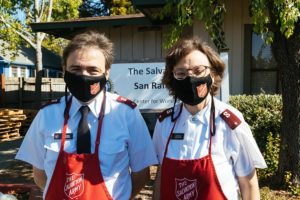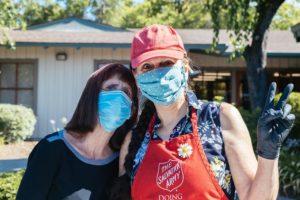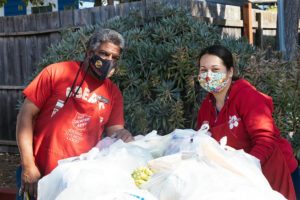 Soup. Soap. And Salvation. Since 1865, The Salvation Army has taken a holistic approach to serve those with the greatest need in our community. According to Diane Shatto, a Lieutenant and ordained minister at San Rafael’s branch of The Salvation Army, you can’t nourish people’s spirits until you nourish them with food. “That’s why our food pantry and home-delivered groceries are key activities for us.”
Soup. Soap. And Salvation. Since 1865, The Salvation Army has taken a holistic approach to serve those with the greatest need in our community. According to Diane Shatto, a Lieutenant and ordained minister at San Rafael’s branch of The Salvation Army, you can’t nourish people’s spirits until you nourish them with food. “That’s why our food pantry and home-delivered groceries are key activities for us.”
The Salvation Army, the Food Bank’s partner agency, serves about 300 people every week at its San Rafael facility. Most are either families from the neighborhood or seniors from the 55+ apartment complexes nearby. The weekly pantry is centrally located, next to the Canal Area and other food bank partners – Marin Community Clinics and Canal Alliance making it accessible for many in the community. The surrounding area is home to many new immigrants and young families – 22% of the Canal population is under the age of 18.
“The partnership with the Food Bank is, well, magical,” said David Shatto, who manages the site along with his wife Diane. “The weekly deliveries of fresh food from the Fresh Rescue program, that comes from your warehouse just down the street on Kerner, keep the pantry well-stocked.” The community-centric approach is the key to our partnerships with organizations throughout San Francisco and Marin. Diane added, “we have the physical space, but we didn’t have the material resources to serve the community, but the Food Bank’s weekly deliveries help. It’s one big piece of the puzzle.”
 Carol Gotti has been volunteering with the Salvation Army’s food program for over ten years, and the participants are a lot more to her than names and numbers. “I’ve gotten to know about people’s lives, and you get a feeling about the things that bring people joy,” she said.
Carol Gotti has been volunteering with the Salvation Army’s food program for over ten years, and the participants are a lot more to her than names and numbers. “I’ve gotten to know about people’s lives, and you get a feeling about the things that bring people joy,” she said.
“One of the senior participants I deliver to has a lot of health issues and allergies, and since I have the time, I give her items that she requests like fruits that won’t interact with her medication or upset her stomach. People feel bad to waste, so it makes her happy that someone is looking out for her.”
When Covid hit and people lost their jobs or hours, many joined Carol as volunteers. “A few are teachers, a few are retirees, and others worked in restaurants,” she said, “It’s important to be doing something so that you feel like you’re thriving, and these volunteers have stayed with us beyond the initial panic of the pandemic.”
“Our model is servant leadership, and though it’s a good feeling to help people, it’s frustrating we can’t do more,” said Diane. “We wish people didn’t have to get creative about feeding their families. What really gets me are the children who walk around hungry, and no one knows or asks them. I was one of those kids.
 “I was the second youngest of five children with three older brothers who were always more aggressive than me about grabbing the food at dinnertime. I had hunger pains all the time, and other kids at school would make fun of me because I was skinny. It makes you feel inferior, you lose motivation, and you lose hope. And that’s how the cycle of poverty continues.”
“I was the second youngest of five children with three older brothers who were always more aggressive than me about grabbing the food at dinnertime. I had hunger pains all the time, and other kids at school would make fun of me because I was skinny. It makes you feel inferior, you lose motivation, and you lose hope. And that’s how the cycle of poverty continues.”
“Ending hunger is about more than just giving food, it’s about providing hope. That’s why our volunteers create such strong relationships with the participants. When you give people food, you build trust, and you can help them in deeper ways. Ultimately, it’s about hope, and when you have that, you can improve lives.”
Carol agreed, “Food is a wonderful way to bring people together, and once you’ve done that, you share life, and you have the sheer joy of being in community with others. For our participants, it’s then an opportunity to pass that on to their families and spread more joy. It’s a perfect 360-degree relationship.”



Share